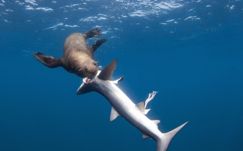Cape seals hunt sharks off Cape Point
By Lorraine Kearney
2 April 2015
The hunted has become the hunter off the coast of Cape Town, where great white
shark
expert Chris Fallows has made a remarkable discovery. Fallows has recorded his
observations of free-swimming blue sharks,
Prionace glauca, being
caught,
killed and partially consumed by Cape fur seals,
Arctocephalus pusillus
pusillus.
It is an important discovery, revealing a previously hidden part of one species' diet,
and
could also have important implications for the understanding of the food web in the
open
ocean.
A study of Fallows' discoveries has been published in the
African Journal of
Marine
Science.
Fallows, who runs the diving group Apex Shark Expeditions, has been working with
sharks since 1992. He spends more time on sea than on land – up to 200 days a
year
tracking and observing sharks.
One day in December 2012, he was taking a group of tourists on a standard shark
dive
20 nautical miles southwest of Cape Point. Fallows put out some bait, which
attracted 10
blue sharks. And then a male Cape fur seal, not quite mature, swam into view.
Feeding frenzy
Instead of going for the bait, as expected, the seal attacked one shark, tearing open
its
abdominal cavity and feeding on the viscera. Not satisfied, it turned to attack a
second
shark. Fallows recorded the seal attack and eat five of the 10 sharks before the
scientist
left, thinking he may be adding to the feeding frenzy.
"I have not seen this behaviour since then," Fallows said after the study was
published
on 31 March, although he has seen seals feeding on small sharks.
In the vast, open ocean not everything has a human witness, but Fallows thinks this
behaviour by seals is not widespread. "Only a small group of seals do this. They
have
probably been forced to because their usual food has been depleted."
There has been a depletion
in the abundance of fish in the open ocean, and Fallows
notes that species are also smaller: "In-shore reef fish have disappeared, there are
fewer in-shore reef sharks and, what there is, is smaller in size than they were
before."
He speculates that the Cape fur seals have been forced to attack predators – "while
they
did not eat full-grown blue sharks, these are efficient predators" – through
desperation
caused by heavy over-fishing by humans.
High nutritional value
Seals' teeth are rounded and cone-shaped – not made for tearing apart the
extremely
tough skin of sharks. Instead, they rely on tearing their prey by shaking it about.
"Going after a shark is a big step. They bite into the softer gills and just eat the
liver,
which is rich in oils and nutrition they need. The stomach is also eaten. The rest of
the
shark is left for other marine creatures to eat."
Full grown, an adult Cape fur seal can reach 3m in size,
although Fallows said this
was
unusually large. Adult blue sharks grow up to 3.3m; large specimens can grow to
3.8m
long. The sub-adult males he witnessed attacking the sharks were about 1.5m in
size,
compared to the 1.4m of the young sharks. "They are punching in different weight
classes. The seal is definitely the apex predator in this relationship," he said.
On the International Union for Conservation of Nature (IUCN) Red List of Threatened
Species, the Cape fur seal population appears to be healthy, and it is classified as
Least
Concern. The population trend of the blue shark is unknown and it is listed as Near
Threatened.
Scientists weigh in
Fallows first witnessed seals attacking sharks in 2004. Again on the open water near
Cape Point, he spotted a young male seal chase and catch a blue shark. The seal
tossed
the shark into the air before eating its stomach and liver.
Hugues Benoit, a fisheries scientist at
Fisheries and Oceans Canada, was intrigued,
and
contacted Fallows. Working with Neil Hammerschlag at the University of Miami,
they
wrote the paper, describing the event and its ecological significance.
Cape fur seals and blue sharks have similar diets, but seals were not previously
known
to turn on their predatory rivals. The seal's consumption of only the most energy-
dense
part of the shark, was also noteworthy, they said.
Unlike Fallows, the scientists said the fact that the seal discarded the rest of its
catch
showed that it had the option to be picky and was probably not at a loss for food.
In its article on the discovery,
The Smithsonian reported the behaviour
suggested that traditional methods of diet estimation for marine mammals might be
missing some key strands in the food web.
"If seals are selectively eating viscera from sharks – or any other large animal –
that
slippery evidence would have evaded scientists'
detection methods, potentially
leading
to a biased picture of who's eating whom."
It also pointed out that predators that only targeted viscera instead of the whole
animal
could have population-level consequences for the prey, because they would have to
kill
so many animals to get their fill.
"Benoit suspects that shark-eating is a natural behaviour for the seals, given that
Fallows first witnessed it in open water where no human activity might somehow be
egging on an abnormal interaction,"
The Smithsonian writes. "Fallows
was
also 'impressed at the ease with which this seal was able to take these sharks',
Benoit
says, implying that this wasn't the seal's first shark-gobbling rodeo."
 A Cape fur seal eviserates a blue shark off Cape Point. (Image: Chris Fallows / hgm-press)
A Cape fur seal eviserates a blue shark off Cape Point. (Image: Chris Fallows / hgm-press)








